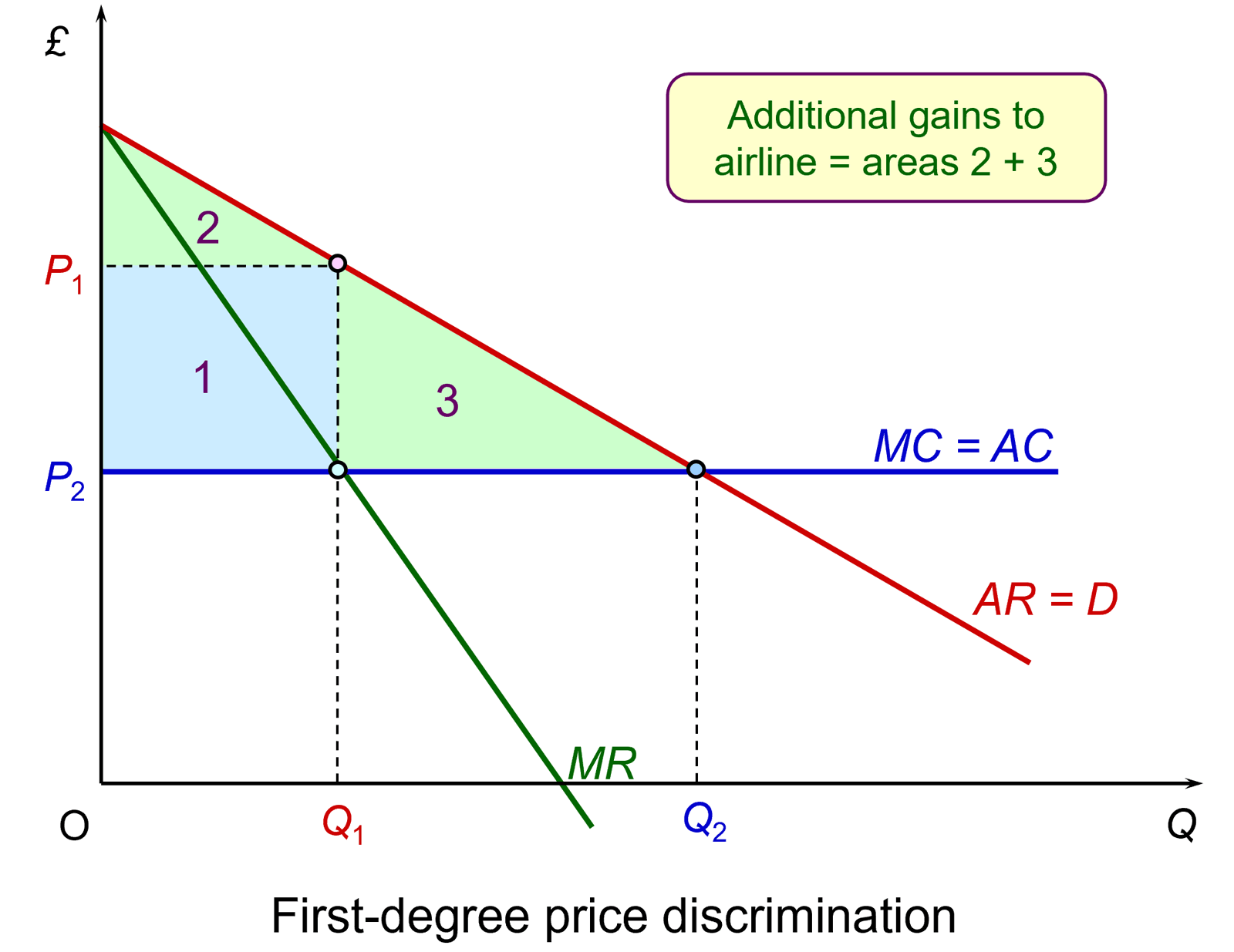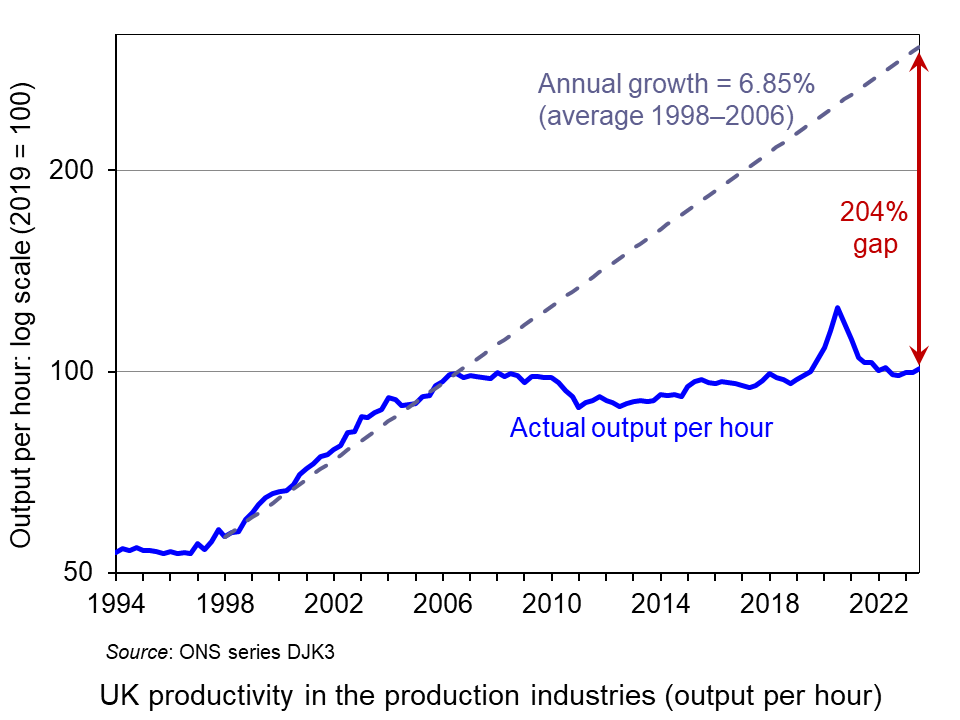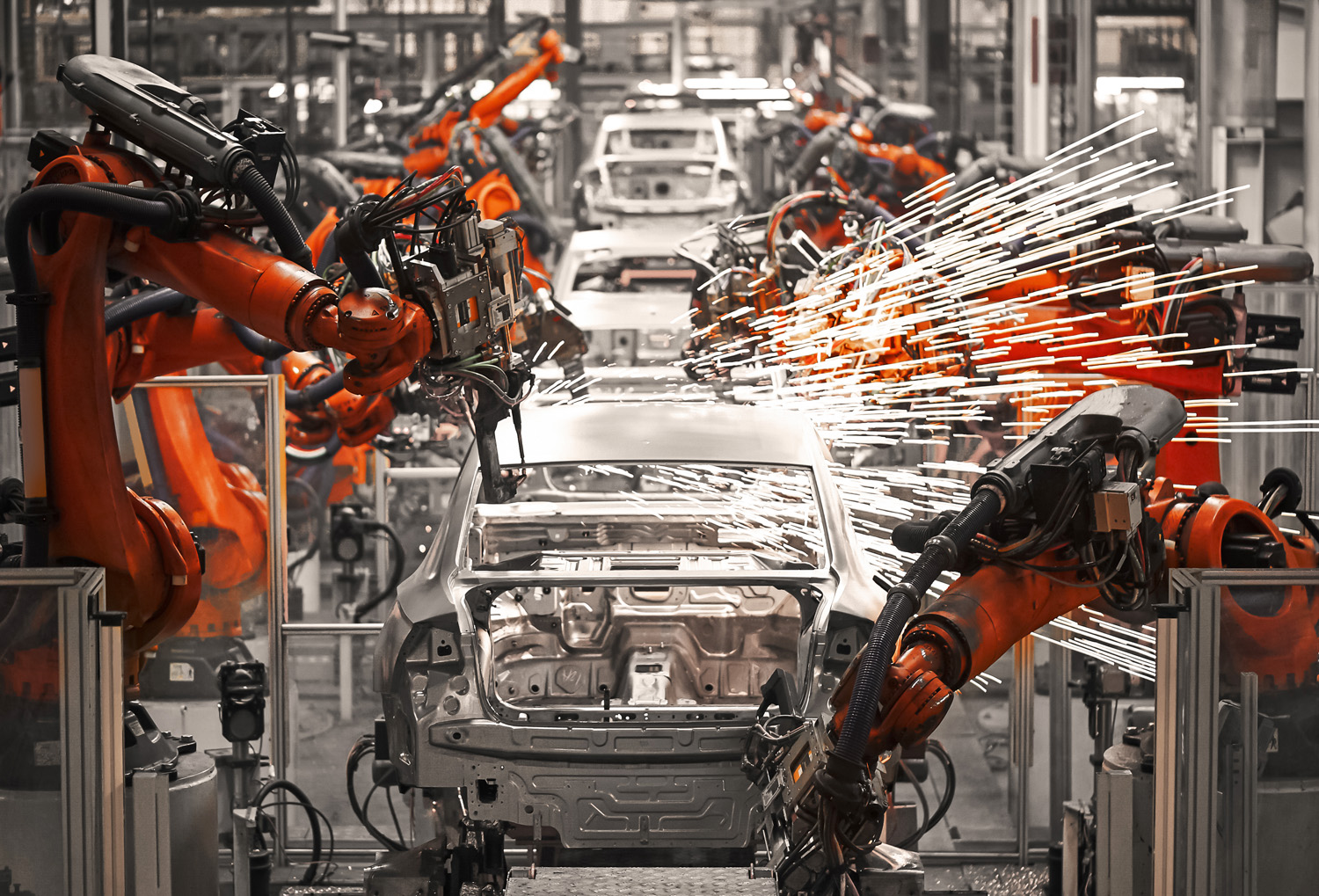 On Saturday 31 August, tickets for the much-heralded Oasis reunion tour went on sale through the official retailer, Ticketmaster. When the company sells tickets, the acts or their promoters can choose whether to use a static pricing system, where each type of ticket is sold at a set price until they have all been sold. Or they can use a dynamic pricing system (‘in-demand’ or ‘platinum’ tickets, as Ticketmaster calls them), where there is a starting price quoted, but where prices then rise according to demand. The higher the demand, the more the price is driven up. Acts or their promoters have the option of choosing an upper limit to the price.
On Saturday 31 August, tickets for the much-heralded Oasis reunion tour went on sale through the official retailer, Ticketmaster. When the company sells tickets, the acts or their promoters can choose whether to use a static pricing system, where each type of ticket is sold at a set price until they have all been sold. Or they can use a dynamic pricing system (‘in-demand’ or ‘platinum’ tickets, as Ticketmaster calls them), where there is a starting price quoted, but where prices then rise according to demand. The higher the demand, the more the price is driven up. Acts or their promoters have the option of choosing an upper limit to the price.
Dynamic pricing
The Oasis tickets were sold under the dynamic pricing system, a system previously used for Harry Styles, Bruce Springsteen, Coldplay and Blackpink concerts, but one rejected by Taylor Swift for her recent Eras tour. Standing tickets for the Oasis concert with a face value of around £135 were quickly being sold for over £350. There were long online queues, with the prices rising as people slowly moved up the queue. When they reached the front, they had to decide quickly whether to pay the much higher price. Some people later suffered from buyer’s remorse, when they realised that in the pressure of the moment, they had paid more than they could afford.
Dynamic pricing is when prices change with market conditions: rising at times when demand exceeds supply and falling when supply exceeds demand. It is sometimes referred to as ‘surge pricing’ to reflect situations when price surges in times of excess demand.
Dynamic pricing is a form of price discrimination. It is an imperfect form of first-degree price discrimination, which is defined as people being charged the maximum price they are willing to pay for a product. Pricing in an eBay auction comes close to first-degree price discrimination. With dynamic pricing in the ticket market, some people may indeed pay the maximum, but others earlier in the queue will be lucky and pay less than their maximum.
Ticketmaster justifies the system of dynamic pricing, saying that it gives ‘fans fair and safe access to the tickets, while enabling artists and other people involved in staging live events to price tickets closer to their true market value’. The company argues that if the price is below the market value, a secondary market will then drive ticket prices up. Ticket touts will purchase large amounts of tickets, often using bots to access the official site and then resell them at highly inflated prices on sites such as Viagogo and Stubhub, where ticket prices for popular acts can sell for well over £1000. The day after Oasis tickets went on sale, Viagogo had seats priced at up to £26 000 each!
Oasis and Ticketmaster have tried to stamp out the unofficial secondary market by stating that only tickets bought through the official retailers (Ticketmaster, Gigsandtours and SeeTickets) will be valid. If fans want to resell a ticket – perhaps because they find they can no longer go – they can resell them on the official secondary market though Ticketmaster’s Fan-to-Fan site or Twickets. These official secondary sites allow holders of unwanted tickets to sell them for anything up to the original face value, but no more. Buyers pay a 12% handling fee. It remains to be seen whether this can be enforced with genuine tickets resold on the secondary market.
Examples of dynamic pricing
 Dynamic pricing is not a new pricing strategy. It has been used for many years in the transport, e-commerce and hospitality sectors. Airlines, for example, have a pricing model whereby as a flight fills up, so the prices of the seats rise. If you book a seat on a budget airline a long time in advance, you may be able to get it at a very low price. If, on the other hand, you want a seat at the last minute, you may well have to pay a very high price. The price reflects the strength of demand and its price elasticity. The business traveller who needs to travel the next day for a meeting will have a very low price sensitivity and may well be prepared to pay a very high price indeed. Airlines also learn from past behaviour and so some popular routes will start at a higher price. A similar system of dynamic pricing is used with advance train tickets, with the price rising as trains get booked up.
Dynamic pricing is not a new pricing strategy. It has been used for many years in the transport, e-commerce and hospitality sectors. Airlines, for example, have a pricing model whereby as a flight fills up, so the prices of the seats rise. If you book a seat on a budget airline a long time in advance, you may be able to get it at a very low price. If, on the other hand, you want a seat at the last minute, you may well have to pay a very high price. The price reflects the strength of demand and its price elasticity. The business traveller who needs to travel the next day for a meeting will have a very low price sensitivity and may well be prepared to pay a very high price indeed. Airlines also learn from past behaviour and so some popular routes will start at a higher price. A similar system of dynamic pricing is used with advance train tickets, with the price rising as trains get booked up.
The dynamic pricing system used by airlines and train companies is similar, but not identical, to first-degree price discrimination. The figure below illustrates first-degree price discrimination by showing a company setting the price for a particular product.
Assume initially that it sets a single profit-maximising price. This would be a price of P1, at an output of Q1, where marginal revenue (MR) equals marginal cost (MC). (We assume for simplicity that average and marginal costs are constant.) Total profit will be area 1: i.e. the blue area ((P1 – AC) × Q1). Area 2 represents consumer surplus, with all those consumers who would have been prepared to pay a price above P1, only having to pay P1.
 Now assume that the firm uses first-degree price discrimination, selling each unit of the product at the maximum price each consumer is willing to pay. Starting with the consumer only willing to pay a price of P2, the price will go on rising up along the demand with each additional consumer being charged a higher price up to the price where the demand curve meets the vertical axis. In such a case, the firm’s profit would be not just the blue area, but also the green areas 2 and 3. Note that there is no consumer surplus as area 2 is now part of the additional profit to the firm.
Now assume that the firm uses first-degree price discrimination, selling each unit of the product at the maximum price each consumer is willing to pay. Starting with the consumer only willing to pay a price of P2, the price will go on rising up along the demand with each additional consumer being charged a higher price up to the price where the demand curve meets the vertical axis. In such a case, the firm’s profit would be not just the blue area, but also the green areas 2 and 3. Note that there is no consumer surplus as area 2 is now part of the additional profit to the firm.
Although dynamic pricing by airlines is similar to this model of first-degree price discrimination, in practice some people will be paying less than they would be willing to pay and the price goes up in stages, not continuously with each new sale of a ticket. Thus, compared with a fixed price per seat, the additional profit will be less than areas 2 + 3, but total profit will still be considerably greater than area 1 alone. Note also that there is a maximum quantity of seats (Qmax), represented by a full flight. The airline would hope that demand and its pricing model are such that Qmax is less than Q2.
Dynamic pricing also applies in the hospitality sector, as hotels raise the prices for rooms according to demand, with prices at peak times often being considerably higher than off-season prices. Rather then pre-setting prices for particular seasons, dates or weekends/weekdays, many hotels, especially chains and booking agents, adjust prices dynamically as demand changes. Airbnb offers property owners what it calls ‘Smart Pricing’, where nightly prices change automatically with demand.
 Another example is Uber, which uses dynamic pricing to balance demand and supply location by location. In times of peak demand on any route, the company’s algorithm will raise the price. This will encourage people to delay travelling if they can or use alternative means of transport. It will also encourage more Uber drivers to come to that area. In times of low demand, the price will fall. This will encourage more people to use the service (rather than regular taxis or buses) and discourage drivers from working in that area.
Another example is Uber, which uses dynamic pricing to balance demand and supply location by location. In times of peak demand on any route, the company’s algorithm will raise the price. This will encourage people to delay travelling if they can or use alternative means of transport. It will also encourage more Uber drivers to come to that area. In times of low demand, the price will fall. This will encourage more people to use the service (rather than regular taxis or buses) and discourage drivers from working in that area.
Where dynamic pricing varies with the time or date when the purchase is made, it is sometimes referred to as inter-temporal pricing. It is a form of second-degree price discrimination, which is where a firm offers consumers a range of different pricing options for the same or similar products.
Another example of dynamic pricing, which is closer to first-degree price discrimination is the use of sophisticated algorithms and AI by Amazon, allowing it to update the prices of millions of products many times a day according to market conditions. Another is eBay auctions, where the price rises as the end date is reached, according to the willingness to pay of the bidders.
Attitudes to dynamic pricing
Consumers have grown accustomed to dynamic pricing in many industries. People generally accept the pricing model of budget airlines, for example. What makes it acceptable is that most people feel that they can take advantage of early low-priced seats and can compare the current prices on different flights and airlines when making their travel plans. Pricing is transparent. With the Oasis concert, however, there wasn’t the same degree of price transparency. Many people were surprised and dismayed to find that when they got to the front of the online queue, the price had risen dramatically.
People are familiar of dynamic pricing in the context of price cuts to shift unsold stock. Supermarkets putting stickers on products saying ‘reduced for quick sale’ is an example. Another is seasonal sales. What is less acceptable to many consumers is firms putting up prices when demand is high. They see it a profiteering. Many supermarkets are introducing electronic shelf labels (ESLs), where prices can be changed remotely as demand changes. Consumers may react badly to this if they see the prices going up. The supermarket, however, may find it a very convenient way of reducing prices to shift stock – something consumers are hardly likely to complain about.
 Returning to the Oasis tour, the UK government responded to the outrage of fans as ticket prices soared. Culture Secretary, Lisa Nandy, announced that the government will investigate how surge pricing for concert tickets is used by official retailers, such as Ticketmaster. This will be part of a planned review of ticket sales that seeks to establish a fairer and more transparent system of pricing.
Returning to the Oasis tour, the UK government responded to the outrage of fans as ticket prices soared. Culture Secretary, Lisa Nandy, announced that the government will investigate how surge pricing for concert tickets is used by official retailers, such as Ticketmaster. This will be part of a planned review of ticket sales that seeks to establish a fairer and more transparent system of pricing.
The problem is that, with some fans being prepared to pay very high prices indeed to see particular acts and with demand considerably exceeding supply at prices that fans would consider reasonable, some way needs to be found of rationing demand. If it is not price, then it will inevitably involve some form of queuing or rationing system, with the danger that this encourages touts and vastly inflated prices on the secondary market.
Perhaps a lesson can be drawn from the Glastonbury Festival, where prices are fixed, people queue online and where security systems are in place to prevent secondary sales by ticket touts. The 2024 price was set at £355 + a £5 booking fee and purchasers were required to register with personal details and a photo, which was checked on admission.
Update
On 5 September, the CMA announced that it was launching an investigation into Ticketmaster over the Oasis concert sales. Its concerns centred on ‘whether buyers were given clear and timely information, and whether consumer protection law was breached’. This followed complaints by fans that (i) they were not given clear and timely information beforehand that the tickets involved dynamic pricing and warned about the possible prices they might have to pay and (ii) on reaching the front of the queue they were put under pressure to buy tickets within a short period of time.
Meanwhile, band member stated that they were unaware that dynamic pricing would be used and that the decision to use the system was made by their management.
Videos
Articles
- Oasis ticket sales – everything you need to know about reunion
BBC News (27/8/24)
- Ticketmaster demand-based pricing system criticised
BBC News, Annabel Rackham (10/10/22)
- I loved Oasis – until I saw Ticketmaster’s dynamic pricing
Metro, Issy Packer (2/9/24)
- A supersonic swindle: my £1,423 Oasis Ticketmaster hell
The Guardian, Josh Halliday (1/9/24)
- Bands urged to oppose dynamic pricing of concert tickets after Oasis ‘fiasco’
The Guardian, Josh Halliday and Rob Davies (1/9/24)
- Oasis tickets: what is dynamic pricing and why is it used for live music?
The Guardian, Rob Davies (1/9/24)
- Viagogo defends reselling Oasis tickets for thousands of pounds as ‘legal’
City A.M. (31/8/24)
- Oasis fans face ‘eye-watering’ resale ticket prices
i News, Adam Sherwin (30/8/240
- Would you really pay €500 for an Oasis ticket?
RTE Brainstorm, Emma Howard (3/9/24)
- When ‘dynamic pricing’ works – and when it doesn’t
Investors’ Chronicle, Hermione Taylor (11/12/23)
- The pros, cons and misconceptions of dynamic pricing for retailers
Computer Weekly, Glynn Davis (20/6/24)
- Dynamic Pricing (Taylor’s Version)
Linkedin, Economic Insight (10/7/23)
- Dynamic pricing: successful companies that use this pricing strategy
PriceTweakers, Simon Gomez (25/5/24)
- Five lessons for businesses investigating dynamic pricing
FT Strategies
- Inflated Oasis ticket prices ‘depressing’ – government promises review of dynamic pricing
Sky News (2/9/24)
- Lisa Nandy hits out at ‘incredibly depressing’ Oasis ticket sale and orders probe into surge pricing
Independent, Archie Mitchell (2/9/24)
- Oasis ticket row: How Ticketmaster’s owner has grip on UK live music scene
BBC News, Chi Chi Izundu and James Stewart (4/9/24)
- CMA launches investigation into Ticketmaster over Oasis concert sales
CMA Press Release (5/9/24)
- Revealed: the touts offering Oasis tickets for thousands on resale sites
The Guardian, Rob Davies, Hannah Al-Othman and Tiago Rogero (7/9/24)
Questions
- What is the difference between dynamic pricing and surge pricing?
- What is buyer’s remorse? How could dynamic pricing be used while minimising the likelihood of buyer’s remorse?
- Distinguish between first-degree, second-degree and third-degree price discrimination. Do the various forms of dynamic pricing correspond to one or more of these three types?
- Distinguish between consumer and producer surplus. How may dynamic pricing lead to a reduction in consumer surplus and an increase in producer surplus?
- Should Ticketmaster sell tickets on the same basis as tickets for the Glastonbury Festival?
- Is Oasis a monopoly? What are the ticket pricing implications?
- Are there any industries where firms would not benefit from dynamic pricing? Explain.
- What are the arguments for and against allowing tickets to be sold on the secondary market for whatever price they will fetch?
- How powerful is Ticketmaster in the primary and secondary ticket markets?
 Global long-term economic growth has slowed dramatically since the financial crisis of 2007–8. This can be illustrated by comparing the two 20-year periods 1988 to 2007 and 2009 to 2028 (where IMF forecasts are used for 2024 to 2028: see WEO Database under the Data link below). Over the two periods, average annual world growth fell from 3.8% to 3.1%. In advanced countries it fell from 2.9% to 1.6% and in developing countries from 4.8% to 4.3%. In the UK it fell from 2.4% to 1.2%, in the USA from 3.1% to 1.8% and in Japan from 1.9% to 0.5%.
Global long-term economic growth has slowed dramatically since the financial crisis of 2007–8. This can be illustrated by comparing the two 20-year periods 1988 to 2007 and 2009 to 2028 (where IMF forecasts are used for 2024 to 2028: see WEO Database under the Data link below). Over the two periods, average annual world growth fell from 3.8% to 3.1%. In advanced countries it fell from 2.9% to 1.6% and in developing countries from 4.8% to 4.3%. In the UK it fell from 2.4% to 1.2%, in the USA from 3.1% to 1.8% and in Japan from 1.9% to 0.5%.
 In the UK, labour productivity growth in the production industries was 6.85% per annum from 1998 to 2006. If this growth rate had been maintained, productivity would have been 204% higher by the end of 2023 than it actually was. This is shown in the chart (click here for a PowerPoint).
In the UK, labour productivity growth in the production industries was 6.85% per annum from 1998 to 2006. If this growth rate had been maintained, productivity would have been 204% higher by the end of 2023 than it actually was. This is shown in the chart (click here for a PowerPoint).
The key driver of long-term economic growth is labour productivity, which can best be measured by real GDP per hour worked. This depends on three things: the amount of capital per worker, the productivity of this capital and the efficiency of workers themselves – the latter two giving total factor productivity (TFP). Productivity growth has slowed, and with it the long-term rate of economic growth.
If we are measuring growth in output per head of the population, as opposed to simple growth in output, then another important factor is the proportion of the population that works. With ageing populations, many countries are facing an increase in the proportion of people not working. In most countries, these demographic pressures are likely to increase.
 A major determinant of long-term economic growth and productivity is investment. Investment has been badly affected by crises, such as the financial crisis and COVID, and by geopolitical tensions, such as the war in Ukraine and tensions between the USA and China and potential trade wars. It has also been adversely affected by government attempts to deal with rising debt caused by interventions following the financial crisis and COVID. The fiscal squeeze and, more recently higher interest rates, have dampened short-term growth and discouraged investment, thereby dampening long-term growth.
A major determinant of long-term economic growth and productivity is investment. Investment has been badly affected by crises, such as the financial crisis and COVID, and by geopolitical tensions, such as the war in Ukraine and tensions between the USA and China and potential trade wars. It has also been adversely affected by government attempts to deal with rising debt caused by interventions following the financial crisis and COVID. The fiscal squeeze and, more recently higher interest rates, have dampened short-term growth and discouraged investment, thereby dampening long-term growth.
Another factor adversely affecting productivity has been a lower growth of allocative efficiency. Competition in many industries has declined as the rate of new firms entering and exiting markets has slowed. The result has been an increase in concentration and a growth in supernormal profits.
In the UK’s case, growth prospects have also been damaged by Brexit. According to Bank of England and OBR estimates, Brexit has reduced productivity by around 4% (see the blog: The costs of Brexit: a clearer picture). For many companies in the UK, Brexit has hugely increased the administrative burdens of trading with the EU. It has also reduced investment and led to a slower growth in the capital stock.
The UK’s poor productivity growth over many yeas is examined in the blog The UK’s poor productivity record.
Boosting productivity
So, how could productivity be increased and what policies could help the process?
 Artificial intelligence. One important driver of productivity growth is technological advance. The rapid advance in AI and its adoption across much of industry is likely to have a dramatic effect on working practices and output. Estimates by the IMF suggest that some 40% of jobs globally and 60% in advanced countries could be affected – some replaced and others complemented and enhanced by AI. The opportunities for raising incomes are huge, but so too are the dangers of displacing workers and deepening inequality, as some higher-paid jobs are enhanced by AI, while many lower paid jobs are little affected and other jobs disappear.
Artificial intelligence. One important driver of productivity growth is technological advance. The rapid advance in AI and its adoption across much of industry is likely to have a dramatic effect on working practices and output. Estimates by the IMF suggest that some 40% of jobs globally and 60% in advanced countries could be affected – some replaced and others complemented and enhanced by AI. The opportunities for raising incomes are huge, but so too are the dangers of displacing workers and deepening inequality, as some higher-paid jobs are enhanced by AI, while many lower paid jobs are little affected and other jobs disappear.
AI is also likely to increase returns to capital. This may help to drive investment and further boost economic growth. However, the increased returns to capital are also likely to exacerbate inequality.
To guard against the growth of market power and its abuse, competition policies may need strengthening to ensure that the benefits of AI are widely spread and that new entrants are encouraged. Also training and retraining opportunities to allow workers to embrace AI and increase their mobility will need to be provided.
 Training. And it is not just training in the use of AI that is important. Training generally is a key ingredient in encouraging productivity growth. In the UK, there has been a decline in investment in adult education and training, with a 70% reduction since the early 2000s in the number of adults undertaking publicly-funded training, and with average spending on training by employers decreasing by 27% per trainee since 2011. The Institute for Fiscal Studies identifies five main policy levers to address this: “public funding of qualifications and skills programmes, loans to learners, training subsidies, taxation of training and the regulation of training” (see link in articles below).
Training. And it is not just training in the use of AI that is important. Training generally is a key ingredient in encouraging productivity growth. In the UK, there has been a decline in investment in adult education and training, with a 70% reduction since the early 2000s in the number of adults undertaking publicly-funded training, and with average spending on training by employers decreasing by 27% per trainee since 2011. The Institute for Fiscal Studies identifies five main policy levers to address this: “public funding of qualifications and skills programmes, loans to learners, training subsidies, taxation of training and the regulation of training” (see link in articles below).
Competition. Another factor likely to enhance productivity is competition, both internationally and within countries. Removing trade restrictions could boost productivity growth; erecting barriers to protect inefficient domestic industry would reduce it.
Investment. Policies to encourage investment are also key to productivity growth. Private-sector investment can be encouraged by tax incentives. For example, in the UK the Annual Investment Allowance allows businesses to claim 100% of the cost of plant and machinery up to £1m in the year it is incurred. However, for tax relief to produce significant effects on investment, companies need to believe that the policy will stay and not be changed as economic circumstances or governments change.
 Public-sector investment is also key. Good road and rail infrastructure and public transport are vital in encouraging private investment and labour mobility. And investment in health, education and training are a key part in encouraging the development of human capital. Many countries, the UK included, cut back on public-sector capital investment after the financial crisis and this has had a dampening effect on economic growth.
Public-sector investment is also key. Good road and rail infrastructure and public transport are vital in encouraging private investment and labour mobility. And investment in health, education and training are a key part in encouraging the development of human capital. Many countries, the UK included, cut back on public-sector capital investment after the financial crisis and this has had a dampening effect on economic growth.
Regional policy. External economies of scale could be encouraged by setting up development areas in various regions. Particular industries could be attracted to specific areas, where local skilled workers, managerial expertise and shared infrastructure can benefit all the firms in the industry. These ‘agglomeration economies’ have been very limited in the UK compared with many other countries with much stronger regional economies.
Changing the aims and governance of firms. A change in corporate structure and governance could also help to drive investment and productivity. According to research by the think tank, Demos (see the B Lab UK article and the second report below), if legislation required companies to consider the social, economic and environmental impact of their business alongside profitability, this could have a dramatic effect on productivity. If businesses were required to be ‘purpose-led’, considering the interests of all their stakeholders, this supply-side reform could dramatically increase growth and well-being.
Such stakeholder-governed businesses currently outperform their peers with higher levels of investment, innovation, product development and output. They also have higher levels of staff engagement and satisfaction.
Articles
- World Must Prioritize Productivity Reforms to Revive Medium-Term Growth
IMF Blog, Nan Li and Diaa Noureldin (10/4/24)
- Why has productivity slowed down?
Oxford Martin School News, Ian Goldin, Pantelis Koutroumpis, François Lafond and Julian Winkler (18/3/24)
- How can the UK revive its ailing productivity?
Economics Observatory, Michelle Kilfoyle (14/3/24)
- With the UK creeping out of recession, here’s an economist’s brief guide to improving productivity
The Conversation, Nigel Driffield (13/3/24)
- UK economy nearly a third smaller thanks to ‘catastrophically bad’ productivity slowdown
City A.M., Chris Dorrell (12/3/24)
- Can AI help solve the UK’s public sector productivity puzzle?
City A.M., Chris Dorrell (11/3/24)
- AI Will Transform the Global Economy. Let’s Make Sure it Benefits Humanity
IMF Blog, Kristalina Georgieva (14/1/24)
- Productivity and Investment: Time to Manage the Project of Renewal
NIESR, Paul Fisher (12/3/24)
- Productivity trends using key national accounts indicators
Eurostat (15/3/24)
- New report says change to company law could add £149bn to the UK economy
B Lab UK (28/11/23)
- Investment in training and skills: Green Budget Chapter 9
Institute for Fiscal Studies, Imran Tahir (12/10/23)
Reports
Data
Questions
- Why has global productivity growth been lower since 2008 than before 2008?
- Why has the UK’s productivity growth been lower than many other advanced economies?
- How does the short-run macroeconomic environment affect long-term growth?
- Find out why Japan’s productivity growth has been so poor compared with other countries.
- What are likely to be the most effective means of increasing productivity growth?
- How may demand management policies affect the supply side of the economy?
- How may the adoption of an ESG framework by companies for setting objectives affect productivity growth?
 The Competition and Markets Authority (CMA) is proposing to launch a formal Market Investigation into anti-competitive practices in the UK’s £2bn veterinary industry (for pets rather than farm animals or horses). This follows a preliminary investigation which received 56 000 responses from pet owners and vet professionals. These responses reported huge rises in bills for treatment and medicines and corresponding rises in the cost of pet insurance.
The Competition and Markets Authority (CMA) is proposing to launch a formal Market Investigation into anti-competitive practices in the UK’s £2bn veterinary industry (for pets rather than farm animals or horses). This follows a preliminary investigation which received 56 000 responses from pet owners and vet professionals. These responses reported huge rises in bills for treatment and medicines and corresponding rises in the cost of pet insurance.
At the same time there has been a large increase in concentration in the industry. In 2013, independent vet practices accounted for 89% of the market; today, they account for only around 40%. Over the past 10 years, some 1500 of the UK’s 5000 vet practices had been acquired by six of the largest corporate groups. In many parts of the country, competition is weak; in others, it is non-existent, with just one of these large companies having a monopoly of veterinary services.
This market power has given rise to a number of issues. The CMA identifies the following:
- Of those practices checked, over 80% had no pricing information online, even for the most basic services. This makes is hard for pet owners to make decisions on treatment.
- Pet owners potentially overpay for medicines, many of which can be bought online or over the counter in pharmacies at much lower prices, with the pet owners merely needing to know the correct dosage. When medicines require a prescription, often it is not made clear to the owners that they can take a prescription elsewhere, and owners end up paying high prices to buy medicines directly from the vet practice.
- Even when there are several vet practices in a local area, they are often owned by the same company and hence there is no price competition. The corporate group often retains the original independent name when it acquires the practice and thus is is not clear to pet owners that ownership has changed. They may think there is local competition when there is not.
 Often the corporate group provides the out-of-hours service, which tends to charge very high prices for emergency services. If there is initially an independent out-of-hours service provider, it may be driven out of business by the corporate owner of day-time services only referring pet owners to its own out-of-hours service.
Often the corporate group provides the out-of-hours service, which tends to charge very high prices for emergency services. If there is initially an independent out-of-hours service provider, it may be driven out of business by the corporate owner of day-time services only referring pet owners to its own out-of-hours service.- The corporate owners may similarly provide other services, such as specialist referral centres, diagnostic labs, animal hospitals and crematoria. By referring pets only to those services owned by itself, this crowds out independents and provides a barrier to the entry of new independents into these parts of the industry.
- Large corporate groups have the incentive to act in ways which may further reduce competition and choice and drive up their profits. They may, for example, invest in advanced equipment, allowing them to provide more sophisticated but high-cost treatment. Simpler, lower-cost treatments may not be offered to pet owners.
- The higher prices in the industry have led to large rises in the cost of pet insurance. These higher insurance costs are made worse by vets steering owners with pet insurance to choosing more expensive treatments for their pets than those without insurance. The Association of British Insurers notes that there has been a large rise in claims attributable to an increasing provision of higher-cost treatments.
- The industry suffers from acute staff shortages, which cuts down on the availability of services and allows practices to push up prices.
- Regulation by the Royal College of Veterinary Surgeons (RCVS) is weak in the area of competition and pricing.
The CMA’s formal investigation will examine the structure of the veterinary industry and the behaviour of the firms in the industry. As the CMA states:
In a well-functioning market, we would expect a range of suppliers to be able to inform consumers of their services and, in turn, consumers would act on the information they receive.
Market failures in the veterinary industry
The CMA’s concerns suggest that the market is not sufficiently competitive, with vet companies holding significant market power. This leads to higher prices for a range of vet services. However, the CMA’s analysis suggests that market failures in the industry extend beyond the simple question of market power and lack of competition.
A crucial market failure is asymmetry of information. The veterinary companies have much better information than pet owners. This is a classic principal–agent problem. The agent, in this case the vet (or vet company), has much better information than the principal, in this case the pet owner. This information can be used to the interests of the vet company, with pet owners being persuaded to purchase more extensive and expensive treatments than they might otherwise choose if they were better informed.
The principal–agent problem also arises in the context of the dependant nature of pets. They are the ones receiving the treatment and, in this context, are the principals. Their owners are the ones acquiring the treatment for them and hence are the pets’ agents. The question is whether the owners will always do the best thing for their pets. This raises philosophical questions of animal rights and whether owners should be required to protect the interests of their pets.
 Another information issue is the short-term perspective of many pet owners. They may purchase a young and healthy pet and assume that it will remain so. However, as the pet gets older, it is likely to face increasing health issues, with correspondingly increasing vet bills. But many owners do not consider such future bills when they purchase the pet. They suffer from what behavioural economists call ‘irrational exuberance’. Such exuberance may also occur when the owner of a sick pet is offered expensive treatment. They may over-optimistically assume that the treatment will be totally successful and that their pet will not need further treatment.
Another information issue is the short-term perspective of many pet owners. They may purchase a young and healthy pet and assume that it will remain so. However, as the pet gets older, it is likely to face increasing health issues, with correspondingly increasing vet bills. But many owners do not consider such future bills when they purchase the pet. They suffer from what behavioural economists call ‘irrational exuberance’. Such exuberance may also occur when the owner of a sick pet is offered expensive treatment. They may over-optimistically assume that the treatment will be totally successful and that their pet will not need further treatment.
Vets cite another information asymmetry. This concerns the costs they face in providing treatment. Many owners are unaware of these costs – costs that include rent, business rates, heating and lighting, staff costs, equipment costs, consumables (such as syringes, dressings, surgical gowns, antiseptic and gloves), VAT, and so on. Many of these costs have risen substantially in recent months and are reflected in the prices pet owners are charged. With people experiencing free health care for themselves from the NHS (or other national provider), this may make them feel that the price of pet health care is excessive.
Then there is the issue of inequality. Pets provide great benefits to many owners and contribute to owners’ well-being. If people on low incomes cannot afford high vet bills, they may either have to forgo having a pet, with the benefits it brings, or incur high vet bills that they ill afford or simply go without treatment for their pets.
 Finally, there are the external costs that arise when people abandon their pets with various health conditions. This has been a growing problem, with many people buying pets during lockdown when they worked from home, only to abandon them later when they have had to go back to the office or other workplace. The costs of treating or putting down such pets are born by charities or local authorities.
Finally, there are the external costs that arise when people abandon their pets with various health conditions. This has been a growing problem, with many people buying pets during lockdown when they worked from home, only to abandon them later when they have had to go back to the office or other workplace. The costs of treating or putting down such pets are born by charities or local authorities.
The CMA is consulting on its proposal to begin a formal Market Investigation. This closes on 11 April. If, in the light of its consultation, the Market Investigation goes ahead, the CMA will later report on its findings and may require the veterinary industry to adopt various measures. These could require vet groups to provide better information to owners, including what lower-cost treatments are available. But given the oligopolistic nature of the industry, it is unlikely to lead to significant reductions in vets bills.
Articles
- UK competition watchdog plans probe into veterinary market
Financial Times, Suzi Ring and Oliver Ralph (12/3/24)
 Vet prices: Investigation over concerns pet owners are being overcharged
Vet prices: Investigation over concerns pet owners are being overchargedSky News (12/3/24)
- UK watchdog plans formal investigation into vet pricing
The Guardian, Kalyeena Makortoff (12/3/24)
- ‘Eye-watering’ vet bills at chain-owned surgeries prompt UK watchdog review
The Guardian, Kalyeena Makortoff (7/9/23)
- Warning pet owners could be overpaying for medicine
BBC News, Lora Jones & Jim Connolly (12/3/24)
- I own a vet practice, owners complain about the spiralling costs of treatments, but I only make 5 -10% profit – here’s our expenditure breakdown
Mail Online, Alanah Khosla (14/3/24)
- Vets bills around the world: As big-name veterinary practices come under pressure for charging pet owners ‘eyewatering’ care costs, how do fees in Britain compare to other countries?
Mail Online, Rory Tingle, Dan Grennan and Katherine Lawton (13/3/24)
CMA documents
Questions
- How would you establish whether there is an abuse of market power in the veterinary industry?
- Explain what is meant by the principal–agent problem. Give some other examples both in economic and non-economic relationships.
- What market advantages do large vet companies have over independent vet practices?
- How might pet insurance lead to (a) adverse selection; (b) moral hazard? Explain. How might (i) insurance companies and (ii) vets help to tackle adverse selection and moral hazard?
- Find out what powers the CMA has to enforce its rulings.
- Search for vet prices and compare the prices charged by at least three vet practices. How would you account for the differences or similarities in prices?
 High-tech firms, such as Google, Amazon, Meta and Apple, have increasingly been gaining the attention of competition authorities across the world, and not in a good way! Over the past few years, competition authorities in the UK, USA and Europe have all opened various cases against Apple, with particular focus on its App Store (see, for example, a blog post on this site from 2021 about the Epic v. Apple case in the USA).
High-tech firms, such as Google, Amazon, Meta and Apple, have increasingly been gaining the attention of competition authorities across the world, and not in a good way! Over the past few years, competition authorities in the UK, USA and Europe have all opened various cases against Apple, with particular focus on its App Store (see, for example, a blog post on this site from 2021 about the Epic v. Apple case in the USA).
The lead-up to the €1.8 billion fine issued by the European Commission (Europe’s competition regulator) on the 4th March 2024, began in 2019 when music streaming provider, Spotify, filed a complaint against Apple, after years of being bound by the ‘unfair’ App Store rules imposed by Apple.1
 Apple’s App Store has traditionally served as the only platform through which application developers can distribute their apps to iOS users, and app developers have had no choice but to adhere to whatever rules are set by Apple. As iPhone and iPad users know, the App Store is the only way in which users can download apps to their iOS devices, establishing Apple’s App Store as a ‘gatekeeper’, as described in the European Commission’s (EC) press release expressing their initial concerns in April 2021.2 When it comes to music streaming apps, Apple not only serves as the exclusive platform for downloading these apps, but also has its own music streaming app, Apple Music, that competes with other music-streaming providers.
Apple’s App Store has traditionally served as the only platform through which application developers can distribute their apps to iOS users, and app developers have had no choice but to adhere to whatever rules are set by Apple. As iPhone and iPad users know, the App Store is the only way in which users can download apps to their iOS devices, establishing Apple’s App Store as a ‘gatekeeper’, as described in the European Commission’s (EC) press release expressing their initial concerns in April 2021.2 When it comes to music streaming apps, Apple not only serves as the exclusive platform for downloading these apps, but also has its own music streaming app, Apple Music, that competes with other music-streaming providers.
 This means that Apple holds a dominant position in the market for the distribution of music streaming apps to iOS users through its App Store. Being a dominant firm is not necessarily a problem. However, firms which hold a dominant position do have a special responsibility not to abuse their position. The EC found that Apple was abusing its dominant position in this market, with particular concerns about the rules it imposed on music streaming app developers.
This means that Apple holds a dominant position in the market for the distribution of music streaming apps to iOS users through its App Store. Being a dominant firm is not necessarily a problem. However, firms which hold a dominant position do have a special responsibility not to abuse their position. The EC found that Apple was abusing its dominant position in this market, with particular concerns about the rules it imposed on music streaming app developers.
Apple requires that app developers use Apple’s own in-app purchase system. This means that users must make any in-app purchases or subscriptions to music streaming apps through Apple’s system, subsequently subjecting app developers to a 30% commission fee. The EC found that this often led app developers to pass on these costs to consumers through an increase in prices.
Although users could still purchase subscriptions outside of the app, which may be cheaper for users as these payments will not be subject to commission, the EC found that Apple limits the ability for app developers to inform users about these alternative methods. For example, Apple prevented app developers from including links within their apps to their websites, where users could purchase subscriptions. The implications of this extends beyond increased prices for consumers, potentially resulting in a degraded user experience as well.
These restrictions imposed by Apple are examples of what are known as ‘anti-steering provisions’, and it is this conduct that led the Commission to issue the fine for the abuse of a dominant market position.
 Whilst this case has now been concluded, the spotlight is not off of Apple yet. The European Commission had required that all ‘gatekeepers’ must comply with their Digital Markets Act (DMA) by the 7 March 2024.3 One implication of this for Apple, is the requirement to allow third-party app stores on iOS devices.
Whilst this case has now been concluded, the spotlight is not off of Apple yet. The European Commission had required that all ‘gatekeepers’ must comply with their Digital Markets Act (DMA) by the 7 March 2024.3 One implication of this for Apple, is the requirement to allow third-party app stores on iOS devices.
Whilst Apple has agreed to this requirement, concerns have been raised about the accompanying measures which Apple will introduce. This includes varying terms for app developers based on whether or not they offer their app exclusively through Apple’s App Store. As outlined in a recent article,4 one implication is that app developers exceeding 1 million existing downloads through the Apple App Store will incur a fee of €0.50 per additional user if they opt to distribute their app also through a competing app store. This may act as a deterrent to popular app developers to offer their app through a competing store.
The success of a platform like an app store, relies greatly on generating ‘network effects’ – more users attract more developers, leading to more users, and so on. Therefore, not being able to offer some of the most popular apps would make it challenging for a new app store to compete effectively with Apple’s App Store.
Recently, Spotify, along with game developer Epic and others, have expressed various concerns about Apple’s compliance with the DMA in a letter to the EC.5 It will be interesting to see whether the EC is satisfied with Apple’s approach to comply with the requirements of the DMA.
References
- A Timeline: How we got here
Time to Play Fair (Spotify) (updated March 2024)
- Antitrust: Commission sends Statement of Objections to Apple on App Store rules for music streaming providers
EC Press Release (30/4/21)
- The Digital Markets Act
EC: Business, Economy, Euro DG
- Apple’s exclusionary app store scheme: An existential moment for the Digital Markets Act
VOXEU, Jacques Crémer, Paul Heidhues, Monika Schnitzer and Fiona Scott Morton (6/3/24)
- A Letter to the European Commission on Apple’s Lack of DMA Compliance
Time to Play Fair (Spotify) (1/3/24)
Articles
Questions
- Why might ‘anti-steering provisions’ that limit the ability of app developers to inform users of alternative purchasing methods be harmful to consumers?
- Why is the existence of Apple’s own music streaming service, Apple Music, particularly significant in the context of its role as the operator of the App Store?
- Reflect on the potential advantages and disadvantages of allowing third-party app stores on iOS devices, as mandated by the Digital Markets Act (DMA).
 On 12 February, it was announced that The Body Shop UK was entering administration. With 199 shops across the country, if this leads to the collapse of the business, some 2000 jobs will be lost. The business has been struggling since 2020 and poor sales this last Christmas led the new owners, the pan-European alternative investment firm, Aurelius, to appoint administrators.
On 12 February, it was announced that The Body Shop UK was entering administration. With 199 shops across the country, if this leads to the collapse of the business, some 2000 jobs will be lost. The business has been struggling since 2020 and poor sales this last Christmas led the new owners, the pan-European alternative investment firm, Aurelius, to appoint administrators.
This could potentially begin an insolvency process that could result in the closure of some or all of the shops. This would spell the end of an iconic brand that, since its founding in 1976, has been associated with natural, ethically sourced and environmentally friendly products. Aurelius has already sold The Body Shop business in most of mainland Europe and in parts of Asia to an unnamed buyer. It is unclear what will happen to the approximately 2800 stores and 8000 employees in 70 countries outside the UK.
Origins of The Body Shop1
 The Body Shop was founded in 1976 and shot to fame in the 1980s. It stood for environmental awareness and an ethical approach to business. But its success had as much to do with what it sold as what it stood for. It sold natural cosmetics – Raspberry Ripple Bathing Bubbles and Camomile Shampoo – products that proved immensely popular with consumers.
The Body Shop was founded in 1976 and shot to fame in the 1980s. It stood for environmental awareness and an ethical approach to business. But its success had as much to do with what it sold as what it stood for. It sold natural cosmetics – Raspberry Ripple Bathing Bubbles and Camomile Shampoo – products that proved immensely popular with consumers.
Its profits increased from a little over £1m in 1985 (€1.7m) to approximately £65m (€77.5m) in 2012. Although profits then slipped, falling to €65.3m in 2014 and €54.8m in 2015, its profit growth in new markets over that same period was 12.4%.
Sales revenue, meanwhile, grew even more dramatically, from £4.9m in 1985 to approximately €967.2m in 2015. By 2015, Body Shop International had over 3100 stores, operating in 61 countries.
What made this success so remarkable is that The Body Shop did virtually no advertising. Its promotion stemmed largely from the activities and environmental campaigning of its founder, Anita Roddick, and the company’s uncompromising claim that it sold only ‘green’ products and conducted its business operations with high ethical standards. It actively supported green causes such as saving whales and protecting rainforests, and it refused to allow its products to be tested on animals. Perhaps most surprising in the world of big business at the time was its high-profile initiative ‘trade not aid’, whereby it claimed to pay ‘fair’ prices for its ingredients, especially those supplied by people in developing countries who were open to exploitation by large companies.
 The growth strategy of The Body Shop focused upon developing a distinctive and highly innovative product range, and at the same time identifying these products with major social issues of the day, such as the environment and animal rights.
The growth strategy of The Body Shop focused upon developing a distinctive and highly innovative product range, and at the same time identifying these products with major social issues of the day, such as the environment and animal rights.
Its initial expansion was based on a process of franchising, where individuals opened Body Shops which were then supplied by the company with its range of just 19 products. Then, in 1984 the company went public. Following its flotation, the share price rose from just 5p to a high of 370p in 1992.
In the 1990s, however, sales growth was less rapid. By 1998, earnings had collapsed by 90% and the share price fell to 117p. Shareholders forced Anita Roddick to step down as Chief Executive, but for a while she and her husband remained as co-chairs. In 2002, they stepped down as co-chairs, by which time profits had fallen to £20.4m. In 2003 she was awarded in knighthood and became Dame Anita Roddick. Sales then grew rapidly from 2004 to 2006 from €553m to €709m.
Acquisition of The Body Shop by L’Oréal
A dramatic event, however, occurred in 2006 when The Body Shop was sold to the French cosmetics giant, L’Oréal, which was 26% owned by Nestlé, The event resulted in the magazine Ethical Consumer downgrading The Body Shop’s ethical rating from 11 out of 20 to a mere 2.5 and calling for a boycott of the company. Three weeks after the sale, the daily BrandIndex recorded an 11 point drop in The Body Shop’s consumer satisfaction rating from 25 to 14.
There were several reasons for this. L’Oréal’s animal-testing policies conflicted with those of The Body Shop and L’Oréal was accused of being involved in price-fixing with other French perfume houses. L’Oréal’s part-owner, Nestlé, was also subject to various criticisms for ethical misconduct, including promoting formula milk rather than breast milk to mothers with babies in developing countries and using slave labour in cocoa farms in West Africa.
 Anita Roddick, however, believed that, by taking over The Body Shop, L’Oréal would develop a more ethical approach to business. Indeed, it did publicly recognise that it needed to develop its ethical and environmental policies.
Anita Roddick, however, believed that, by taking over The Body Shop, L’Oréal would develop a more ethical approach to business. Indeed, it did publicly recognise that it needed to develop its ethical and environmental policies.
L’Oréal adopted a new Code of Business Ethics in 2007 and gained some external accreditation for its approach to sustainability and ethics. It was ranked as one of the world’s 100 most ethical companies by Ethisphere in 2007 and, in 2016, it was again part of this list for the seventh time.
L’Oréal set itself three targets as part of its environmental strategy (2005–15), including a 50% reduction in greenhouse gas emissions, water consumption and waste per finished product unit. It made a donation of $1.2m to the US Environment Protection Agency to help bring an end to animal testing and, in March 2013, it announced a ‘total ban on the sale in Europe of any cosmetic product that was tested on animals or containing an ingredient that was tested on animals after this date.’ It also promised that ‘By 2020, we will innovate so that 100% of products have an environmental or social benefit.’
 Sadly, Anita Roddick died in 2007 and so was not able to witness these changes.
Sadly, Anita Roddick died in 2007 and so was not able to witness these changes.
L’Oréal also looked to inject greater finance into the company aimed at improving the marketing of products. In autumn 2006 a transactional website was launched and there have been larger press marketing campaigns. Profits continued to rise in 2006 and 2007, but fell back quite dramatically from €64m in 2007 to €36m in 2008 as recession hit the high streets. They fell by a further 8% in 2009, but significant growth was seen in the following three years: 2010, up 20.3% to €65.3m; 2011, up 4.3% to €68.1m; 2012, up 13.8% to €77.5m.
From L’Oréal to Natura to Aurelius to ?
 From 2013, the financial performance of The Body Shop deteriorated. Profits fell by 38% in 2016 to just €34m, with sales falling by 5%. In June 2017, L’Oréal announced that it had agreed to sell The Body Shop for €1bn (£877m) to Natura Cosmeticos, the largest Brazilian cosmetics business. Natura was awarded ‘B Corp’ status in 2014 as it met certain standards for environmental performance, accountability and transparency. In 2019, The Body Shop was separately certified as a B Corp.
From 2013, the financial performance of The Body Shop deteriorated. Profits fell by 38% in 2016 to just €34m, with sales falling by 5%. In June 2017, L’Oréal announced that it had agreed to sell The Body Shop for €1bn (£877m) to Natura Cosmeticos, the largest Brazilian cosmetics business. Natura was awarded ‘B Corp’ status in 2014 as it met certain standards for environmental performance, accountability and transparency. In 2019, The Body Shop was separately certified as a B Corp.
Initial indications for The Body Shop under its new owners seemed good, with net revenue rising by 36% in 2018 and 6.3% in 2019. 2020 saw strong growth in sales, with a rise in online sales more than offsetting the effect of store closures during the pandemic. Its market share peaked in 2020 at 1.4%. However, with the cost-of-living crisis following the pandemic and the Russian invasion of Ukraine, many consumers switched to cheaper brands and cheaper outlets, such as Boots and Superdrug, sacrificing environmental and ethical concerns in favour of value for money. As a result, The Body Shop’s market share fell, dropping to 0.8% in 2022 and not picking up in 2023.
This prompted Natura to sell the business to Aurelius. Aurelius hoped to revitalise The Body Shop by promoting its core values and through partnerships or concessions with major retailers, such as John Lewis or Next. However, as we saw above, after a poor Christmas and a weaker capital base and higher cost commitments than initially thought by Aurelius, the new owner filed to put The Body Shop into administration.
What will come of the administration process remains to be seen. Perhaps some of the more profitable stores will be saved; perhaps there will be an expansion of the online business; perhaps partnerships will be sought with major retailers. We shall see.
1 Some of this section is based on Case Study 9.3 from Economics (11th edition).
Videos
Articles
- Aurelius Acquires Iconic Global Beauty Brand and Retailer, The Body Shop
Aurelius news (14/11/23)
- Back to the future? What’s next for the Body Shop brand
Marketing Week, Niamh Carroll (14/11/23)
- The Body Shop appoints administrators for UK business
Financial Times, Laura Onita and Will Louch (13/2/24)
- The Body Shop set to appoint administrators for UK arm
Financial Times, Laura Onita (10/2/24)
- The Body Shop collapses into administration in UK
The Guardian, Sarah Butler and Rob Davies (13/2/24)
- The Body Shop UK in administration – what went wrong?
Sky News, James Sillars (13/2/24)
- Body Shop UK jobs and stores at risk in race to save firm
BBC News (13/2/24)
- From cult status to closure fears — what happened to The Body Shop?
CBC News, Natalie Stechyson (12/2/24)
- Headed for administration, why did The Body Shop fail?
Startups, Richard Parris (12/2/24)
- Comment: The Body Shop’s woes hit just as it should be at its most relevant
TheIndustry.beauty, Lauretta Roberts (13/2/24)
- The collapse of The Body Shop shows that ‘ethical’ branding is not a free pass to commercial success
The Conversation, Kokho Jason Sit (15/2/24)
Questions
- What assumptions did The Body Shop made about the ‘rational consumer’?
- How would you describe the aims of The Body Shop (a) in the early days under Anita Roddick; (b) under L’Oréal; (c) under Aurelius?
- How has The Body Shop’s economic performance been affected by its attitudes towards ethical issues?
- What has Lush done right that The Body Shop has not?
- What will the administrators seek to do?
- Find out what has happened to The Body Shop outlets in mainland Europe?
 On Saturday 31 August, tickets for the much-heralded Oasis reunion tour went on sale through the official retailer, Ticketmaster. When the company sells tickets, the acts or their promoters can choose whether to use a static pricing system, where each type of ticket is sold at a set price until they have all been sold. Or they can use a dynamic pricing system (‘in-demand’ or ‘platinum’ tickets, as Ticketmaster calls them), where there is a starting price quoted, but where prices then rise according to demand. The higher the demand, the more the price is driven up. Acts or their promoters have the option of choosing an upper limit to the price.
On Saturday 31 August, tickets for the much-heralded Oasis reunion tour went on sale through the official retailer, Ticketmaster. When the company sells tickets, the acts or their promoters can choose whether to use a static pricing system, where each type of ticket is sold at a set price until they have all been sold. Or they can use a dynamic pricing system (‘in-demand’ or ‘platinum’ tickets, as Ticketmaster calls them), where there is a starting price quoted, but where prices then rise according to demand. The higher the demand, the more the price is driven up. Acts or their promoters have the option of choosing an upper limit to the price. Dynamic pricing is not a new pricing strategy. It has been used for many years in the transport, e-commerce and hospitality sectors. Airlines, for example, have a pricing model whereby as a flight fills up, so the prices of the seats rise. If you book a seat on a budget airline a long time in advance, you may be able to get it at a very low price. If, on the other hand, you want a seat at the last minute, you may well have to pay a very high price. The price reflects the strength of demand and its price elasticity. The business traveller who needs to travel the next day for a meeting will have a very low price sensitivity and may well be prepared to pay a very high price indeed. Airlines also learn from past behaviour and so some popular routes will start at a higher price. A similar system of dynamic pricing is used with advance train tickets, with the price rising as trains get booked up.
Dynamic pricing is not a new pricing strategy. It has been used for many years in the transport, e-commerce and hospitality sectors. Airlines, for example, have a pricing model whereby as a flight fills up, so the prices of the seats rise. If you book a seat on a budget airline a long time in advance, you may be able to get it at a very low price. If, on the other hand, you want a seat at the last minute, you may well have to pay a very high price. The price reflects the strength of demand and its price elasticity. The business traveller who needs to travel the next day for a meeting will have a very low price sensitivity and may well be prepared to pay a very high price indeed. Airlines also learn from past behaviour and so some popular routes will start at a higher price. A similar system of dynamic pricing is used with advance train tickets, with the price rising as trains get booked up. Now assume that the firm uses first-degree price discrimination, selling each unit of the product at the maximum price each consumer is willing to pay. Starting with the consumer only willing to pay a price of P2, the price will go on rising up along the demand with each additional consumer being charged a higher price up to the price where the demand curve meets the vertical axis. In such a case, the firm’s profit would be not just the blue area, but also the green areas 2 and 3. Note that there is no consumer surplus as area 2 is now part of the additional profit to the firm.
Now assume that the firm uses first-degree price discrimination, selling each unit of the product at the maximum price each consumer is willing to pay. Starting with the consumer only willing to pay a price of P2, the price will go on rising up along the demand with each additional consumer being charged a higher price up to the price where the demand curve meets the vertical axis. In such a case, the firm’s profit would be not just the blue area, but also the green areas 2 and 3. Note that there is no consumer surplus as area 2 is now part of the additional profit to the firm. Another example is Uber, which uses dynamic pricing to balance demand and supply location by location. In times of peak demand on any route, the company’s algorithm will raise the price. This will encourage people to delay travelling if they can or use alternative means of transport. It will also encourage more Uber drivers to come to that area. In times of low demand, the price will fall. This will encourage more people to use the service (rather than regular taxis or buses) and discourage drivers from working in that area.
Another example is Uber, which uses dynamic pricing to balance demand and supply location by location. In times of peak demand on any route, the company’s algorithm will raise the price. This will encourage people to delay travelling if they can or use alternative means of transport. It will also encourage more Uber drivers to come to that area. In times of low demand, the price will fall. This will encourage more people to use the service (rather than regular taxis or buses) and discourage drivers from working in that area. Returning to the Oasis tour, the UK government responded to the outrage of fans as ticket prices soared. Culture Secretary, Lisa Nandy, announced that the government will investigate how surge pricing for concert tickets is used by official retailers, such as Ticketmaster. This will be part of a planned review of ticket sales that seeks to establish a fairer and more transparent system of pricing.
Returning to the Oasis tour, the UK government responded to the outrage of fans as ticket prices soared. Culture Secretary, Lisa Nandy, announced that the government will investigate how surge pricing for concert tickets is used by official retailers, such as Ticketmaster. This will be part of a planned review of ticket sales that seeks to establish a fairer and more transparent system of pricing. Oasis ticket row: Government vows to act over ‘dynamic pricing’
Oasis ticket row: Government vows to act over ‘dynamic pricing’ Oasis tickets turmoil: UK government to probe dynamic pricing
Oasis tickets turmoil: UK government to probe dynamic pricing What is Dynamic Pricing? How does Uber set its prices?
What is Dynamic Pricing? How does Uber set its prices? Dynamic Pricing, Explained: AI business model | Uber Surge pricing
Dynamic Pricing, Explained: AI business model | Uber Surge pricing Why did Oasis tickets use dynamic pricing?
Why did Oasis tickets use dynamic pricing? Global long-term economic growth has slowed dramatically since the financial crisis of 2007–8. This can be illustrated by comparing the two 20-year periods 1988 to 2007 and 2009 to 2028 (where IMF forecasts are used for 2024 to 2028: see WEO Database under the Data link below). Over the two periods, average annual world growth fell from 3.8% to 3.1%. In advanced countries it fell from 2.9% to 1.6% and in developing countries from 4.8% to 4.3%. In the UK it fell from 2.4% to 1.2%, in the USA from 3.1% to 1.8% and in Japan from 1.9% to 0.5%.
Global long-term economic growth has slowed dramatically since the financial crisis of 2007–8. This can be illustrated by comparing the two 20-year periods 1988 to 2007 and 2009 to 2028 (where IMF forecasts are used for 2024 to 2028: see WEO Database under the Data link below). Over the two periods, average annual world growth fell from 3.8% to 3.1%. In advanced countries it fell from 2.9% to 1.6% and in developing countries from 4.8% to 4.3%. In the UK it fell from 2.4% to 1.2%, in the USA from 3.1% to 1.8% and in Japan from 1.9% to 0.5%. In the UK, labour productivity growth in the production industries was 6.85% per annum from 1998 to 2006. If this growth rate had been maintained, productivity would have been 204% higher by the end of 2023 than it actually was. This is shown in the chart (click
In the UK, labour productivity growth in the production industries was 6.85% per annum from 1998 to 2006. If this growth rate had been maintained, productivity would have been 204% higher by the end of 2023 than it actually was. This is shown in the chart (click  A major determinant of long-term economic growth and productivity is investment. Investment has been badly affected by crises, such as the financial crisis and COVID, and by geopolitical tensions, such as the war in Ukraine and tensions between the USA and China and potential trade wars. It has also been adversely affected by government attempts to deal with rising debt caused by interventions following the financial crisis and COVID. The fiscal squeeze and, more recently higher interest rates, have dampened short-term growth and discouraged investment, thereby dampening long-term growth.
A major determinant of long-term economic growth and productivity is investment. Investment has been badly affected by crises, such as the financial crisis and COVID, and by geopolitical tensions, such as the war in Ukraine and tensions between the USA and China and potential trade wars. It has also been adversely affected by government attempts to deal with rising debt caused by interventions following the financial crisis and COVID. The fiscal squeeze and, more recently higher interest rates, have dampened short-term growth and discouraged investment, thereby dampening long-term growth. Artificial intelligence. One important driver of productivity growth is technological advance. The rapid advance in AI and its adoption across much of industry is likely to have a dramatic effect on working practices and output.
Artificial intelligence. One important driver of productivity growth is technological advance. The rapid advance in AI and its adoption across much of industry is likely to have a dramatic effect on working practices and output.  Training. And it is not just training in the use of AI that is important. Training generally is a key ingredient in encouraging productivity growth. In the UK, there has been a decline in investment in adult education and training, with a 70% reduction since the early 2000s in the number of adults undertaking publicly-funded training, and with average spending on training by employers decreasing by 27% per trainee since 2011. The Institute for Fiscal Studies identifies five main policy levers to address this: “public funding of qualifications and skills programmes, loans to learners, training subsidies, taxation of training and the regulation of training” (see link in articles below).
Training. And it is not just training in the use of AI that is important. Training generally is a key ingredient in encouraging productivity growth. In the UK, there has been a decline in investment in adult education and training, with a 70% reduction since the early 2000s in the number of adults undertaking publicly-funded training, and with average spending on training by employers decreasing by 27% per trainee since 2011. The Institute for Fiscal Studies identifies five main policy levers to address this: “public funding of qualifications and skills programmes, loans to learners, training subsidies, taxation of training and the regulation of training” (see link in articles below). Public-sector investment is also key. Good road and rail infrastructure and public transport are vital in encouraging private investment and labour mobility. And investment in health, education and training are a key part in encouraging the development of human capital. Many countries, the UK included, cut back on public-sector capital investment after the financial crisis and this has had a dampening effect on economic growth.
Public-sector investment is also key. Good road and rail infrastructure and public transport are vital in encouraging private investment and labour mobility. And investment in health, education and training are a key part in encouraging the development of human capital. Many countries, the UK included, cut back on public-sector capital investment after the financial crisis and this has had a dampening effect on economic growth. The Competition and Markets Authority (CMA) is proposing to launch a formal Market Investigation into anti-competitive practices in the UK’s £2bn veterinary industry (for pets rather than farm animals or horses). This follows a preliminary investigation which received 56 000 responses from pet owners and vet professionals. These responses reported huge rises in bills for treatment and medicines and corresponding rises in the cost of pet insurance.
The Competition and Markets Authority (CMA) is proposing to launch a formal Market Investigation into anti-competitive practices in the UK’s £2bn veterinary industry (for pets rather than farm animals or horses). This follows a preliminary investigation which received 56 000 responses from pet owners and vet professionals. These responses reported huge rises in bills for treatment and medicines and corresponding rises in the cost of pet insurance. Often the corporate group provides the out-of-hours service, which tends to charge very high prices for emergency services. If there is initially an independent out-of-hours service provider, it may be driven out of business by the corporate owner of day-time services only referring pet owners to its own out-of-hours service.
Often the corporate group provides the out-of-hours service, which tends to charge very high prices for emergency services. If there is initially an independent out-of-hours service provider, it may be driven out of business by the corporate owner of day-time services only referring pet owners to its own out-of-hours service. Another information issue is the short-term perspective of many pet owners. They may purchase a young and healthy pet and assume that it will remain so. However, as the pet gets older, it is likely to face increasing health issues, with correspondingly increasing vet bills. But many owners do not consider such future bills when they purchase the pet. They suffer from what behavioural economists call ‘irrational exuberance’. Such exuberance may also occur when the owner of a sick pet is offered expensive treatment. They may over-optimistically assume that the treatment will be totally successful and that their pet will not need further treatment.
Another information issue is the short-term perspective of many pet owners. They may purchase a young and healthy pet and assume that it will remain so. However, as the pet gets older, it is likely to face increasing health issues, with correspondingly increasing vet bills. But many owners do not consider such future bills when they purchase the pet. They suffer from what behavioural economists call ‘irrational exuberance’. Such exuberance may also occur when the owner of a sick pet is offered expensive treatment. They may over-optimistically assume that the treatment will be totally successful and that their pet will not need further treatment. Finally, there are the external costs that arise when people abandon their pets with various health conditions. This has been a growing problem, with many people buying pets during lockdown when they worked from home, only to abandon them later when they have had to go back to the office or other workplace. The costs of treating or putting down such pets are born by charities or local authorities.
Finally, there are the external costs that arise when people abandon their pets with various health conditions. This has been a growing problem, with many people buying pets during lockdown when they worked from home, only to abandon them later when they have had to go back to the office or other workplace. The costs of treating or putting down such pets are born by charities or local authorities. High-tech firms, such as Google, Amazon, Meta and Apple, have increasingly been gaining the attention of competition authorities across the world, and not in a good way! Over the past few years, competition authorities in the UK, USA and Europe have all opened various cases against Apple, with particular focus on its App Store (see, for example,
High-tech firms, such as Google, Amazon, Meta and Apple, have increasingly been gaining the attention of competition authorities across the world, and not in a good way! Over the past few years, competition authorities in the UK, USA and Europe have all opened various cases against Apple, with particular focus on its App Store (see, for example,  Apple’s App Store has traditionally served as the only platform through which application developers can distribute their apps to iOS users, and app developers have had no choice but to adhere to whatever rules are set by Apple. As iPhone and iPad users know, the App Store is the only way in which users can download apps to their iOS devices, establishing Apple’s App Store as a ‘gatekeeper’, as described in the European Commission’s (EC) press release expressing their initial concerns in April 2021.2 When it comes to music streaming apps, Apple not only serves as the exclusive platform for downloading these apps, but also has its own music streaming app, Apple Music, that competes with other music-streaming providers.
Apple’s App Store has traditionally served as the only platform through which application developers can distribute their apps to iOS users, and app developers have had no choice but to adhere to whatever rules are set by Apple. As iPhone and iPad users know, the App Store is the only way in which users can download apps to their iOS devices, establishing Apple’s App Store as a ‘gatekeeper’, as described in the European Commission’s (EC) press release expressing their initial concerns in April 2021.2 When it comes to music streaming apps, Apple not only serves as the exclusive platform for downloading these apps, but also has its own music streaming app, Apple Music, that competes with other music-streaming providers.  This means that Apple holds a dominant position in the market for the distribution of music streaming apps to iOS users through its App Store. Being a dominant firm is not necessarily a problem. However, firms which hold a dominant position do have a special responsibility not to abuse their position. The EC found that Apple was abusing its dominant position in this market, with particular concerns about the rules it imposed on music streaming app developers.
This means that Apple holds a dominant position in the market for the distribution of music streaming apps to iOS users through its App Store. Being a dominant firm is not necessarily a problem. However, firms which hold a dominant position do have a special responsibility not to abuse their position. The EC found that Apple was abusing its dominant position in this market, with particular concerns about the rules it imposed on music streaming app developers.  Whilst this case has now been concluded, the spotlight is not off of Apple yet. The European Commission had required that all ‘gatekeepers’ must comply with their Digital Markets Act (DMA) by the 7 March 2024.3 One implication of this for Apple, is the requirement to allow third-party app stores on iOS devices.
Whilst this case has now been concluded, the spotlight is not off of Apple yet. The European Commission had required that all ‘gatekeepers’ must comply with their Digital Markets Act (DMA) by the 7 March 2024.3 One implication of this for Apple, is the requirement to allow third-party app stores on iOS devices. On 12 February, it was announced that
On 12 February, it was announced that  The Body Shop was founded in 1976 and shot to fame in the 1980s. It stood for environmental awareness and an ethical approach to business. But its success had as much to do with what it sold as what it stood for. It sold natural cosmetics – Raspberry Ripple Bathing Bubbles and Camomile Shampoo – products that proved immensely popular with consumers.
The Body Shop was founded in 1976 and shot to fame in the 1980s. It stood for environmental awareness and an ethical approach to business. But its success had as much to do with what it sold as what it stood for. It sold natural cosmetics – Raspberry Ripple Bathing Bubbles and Camomile Shampoo – products that proved immensely popular with consumers. The growth strategy of The Body Shop focused upon developing a distinctive and highly innovative product range, and at the same time identifying these products with major social issues of the day, such as the environment and animal rights.
The growth strategy of The Body Shop focused upon developing a distinctive and highly innovative product range, and at the same time identifying these products with major social issues of the day, such as the environment and animal rights. Anita Roddick, however, believed that, by taking over The Body Shop, L’Oréal would develop a more ethical approach to business. Indeed, it did publicly recognise that it needed to develop its ethical and environmental policies.
Anita Roddick, however, believed that, by taking over The Body Shop, L’Oréal would develop a more ethical approach to business. Indeed, it did publicly recognise that it needed to develop its ethical and environmental policies. Sadly, Anita Roddick died in 2007 and so was not able to witness these changes.
Sadly, Anita Roddick died in 2007 and so was not able to witness these changes. From 2013, the financial performance of The Body Shop deteriorated. Profits fell by 38% in 2016 to just €34m, with sales falling by 5%. In June 2017, L’Oréal announced that it had agreed to sell The Body Shop for €1bn (£877m) to
From 2013, the financial performance of The Body Shop deteriorated. Profits fell by 38% in 2016 to just €34m, with sales falling by 5%. In June 2017, L’Oréal announced that it had agreed to sell The Body Shop for €1bn (£877m) to